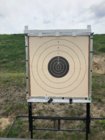This makes me wonder about target frame mounting rigidity. I have been led to believe that the accuracy of these types of electronic targets is reduced (sometimes significantly) if there is any wobble in the target and that care must be used to insure the target can't sway or move at all in the wind.
I have the impression that a typical existing fixed target support may or may not be suitable for an E.T. face and that a typical target system which is raised and lowered behind a berm is almost surely too wobbly to be used with an E.T. face.
Have I been misinformed as to how important rigid target face mounting is? Every up-and-down target carrier associated with a pit and berm configuration that I've ever used is shaky to one degree or another. Can a simple E.T. target frame be mounted to such a carrier and be expected to work properly or not? Perhaps Adam can chime in here.
Yes it is important. However it is not NEARLY as important with 8 sensors as it is with 5.
The newer 8 sensor design can measure and account for the incoming angle of the bullet, so any static change in orientation is not a problem at all. This is why you can calibrate the frame once and shoot in any position at any distance. The calibration is valid forever as long as you put your paper target in the same place and don't move the brackets.
With 8 sensors the only problem left is when the target is physically in motion at the instant the bullet arrives. This will produce a random error of up to maybe 1/4". It's the only significant source of random error, but it's not much in the big picture.
With the 5 sensor systems that most people have used over the past few years, any orientation change produces both a large calibration shift as well as a skewing of the pattern of reported shots. If the frame is rocking back and forth in the wind, this can easily be multiple inches of random elevation shot to shot during your string. At our club we went to great effort to solve this by levering the frame back with a 2x4 under tension from a ratchet strap, and doubling the 2x6 legs to increase stiffness.
As long as the frame isn't freely rocking back and forth excessively, it's fine. With 8 sensors, a little flex in the frame is fine. As long as you aren't measuring every bullet hole with calipers to post a review of e-target accuracy on a windy day, it's fine. Just put some reasonable effort into securing the frame and shoot your match.
ShotMarker will tell you if your frame isn't straight enough or isn't secured properly. It can measure shot quality (frame straightness) and the variation of the apparent incoming angle of the shots in a string. There should be no guessing. I have been analyzing data from customers, advising when their frames could use some work, and improving the built in software to provide relevant information so I don't have to analyze the data myself.













